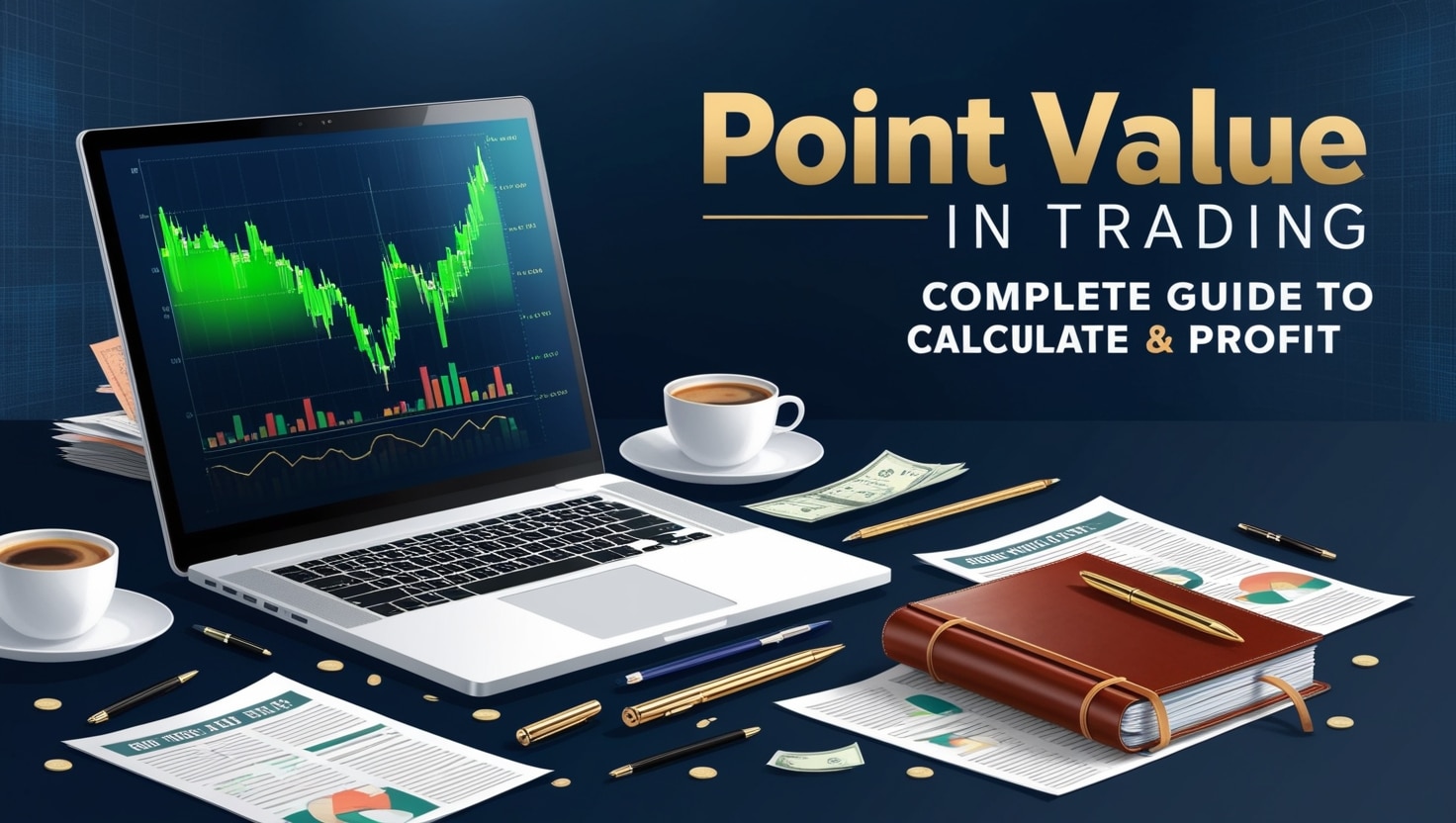
Have you ever considered why a single movement in point in the financial realm can lead to the emergence of multiple profits and losses? If you want to dive deeper and understand the nuances that cause this, learning about price movements and their direct impact on your trading journey should be your first priority.
Point Value is a representative of the value of each price movement that occurs in your chosen financial instrument. Improving your skills and having mastery over point value calculation is crucial for the correct assessment of profit and risk management irrespective of whether you are into the trading of stocks, futures or any other financial markets.
This Comprehensive guide will help you walk through, how to:
- Calculate point value across different markets
- Use point value to measure potential profits and losses
- Apply point value in your risk management strategy
- Make more informed trading decisions based on price movements
Let’s explore how understanding point value can transform your approach to trading and help you trade with greater confidence.
Key Takeaways
Essential Concepts
✓ Point Value: The monetary value of a single point movement in your trading instrument ✓ Market Impact: Determines your profit or loss based on contract size × minimum price change ✓ Price Movement: Represents the smallest measurable change in market price (left of decimal)
Practical Applications
📈 Profit Calculation
- Standard point value = Contract size × minimum price movement
- Example: In crude oil futures, 1 point = $1,000 (1,000 barrels × $1.00)
🎯 Risk Management
- Use point value to set precise stop-loss levels
- Calculate position sizes based on risk tolerance
- Determine appropriate leverage ratios
Market-Specific Differences
| Market Type | Point Measurement | Typical Value Range |
|---|---|---|
| Forex | Pip (0.0001) | $0.10 – $10 per pip |
| Futures | Tick | $5 – $50 per tick |
| Stocks | Point ($0.01) | $1 per point |
Critical Considerations
⚠️ Always verify point value before trading
⚠️ Point value changes with contract size
⚠️ Different markets use different terminology
What is Point Value in Trading?
If you’re new to trading, understanding point value is crucial to your success. It’s the foundation of how we measure price movements and calculate potential profits or losses in any market. Let me break this down in simple terms.
The Basics of Point Value
Point value is essentially the monetary worth of each price movement in your trading instrument. Think of it as a multiplier that converts those small price changes you see on your screen into actual dollars and cents in your trading account.
There are three key elements that make up point value:
Core Components of Point Value
- Contract Size
- The standard amount of an asset in one trading contract
- Example: One E-mini S&P 500 futures contract = $50 × S&P 500 index
- Minimum Price Movement
- The smallest possible price change (tick size)
- Varies by market and instrument
- Example: EUR/USD forex pair = 0.0001 (1 pip)
- Multiplier Effect
- Point Value = Contract Size × Minimum Price Movement
- Determines actual profit/loss per point movement
Let me show you how this works in real life.
Real-World Examples That Make It Click
Imagine you’re trading stocks – let’s say 100 shares of Apple (AAPL). Every time the price moves by one cent ($0.01), your position value changes by $1.00 (100 shares × $0.01). So if AAPL moves from $150.00 to $151.00, that one-dollar move translates to a $100 change in your position value.
Futures trading works a bit differently. Take the popular E-mini S&P 500 futures contract. Here, each point of movement in the index is worth a fixed $50. So when the index moves from 4,000 to 4,001 (a one-point move), your position changes by $50, regardless of the index’s actual price level.
Why Understanding Point Value is Critical
Knowledge of point value isn’t just about calculating profits – it’s fundamental to managing your risk effectively. Here’s why it matters:

- Risk Assessment It helps you calculate potential losses accurately and set precise stop-loss levels. Without this understanding, you’re essentially trading blind.
- Position Sizing Knowing your point value helps determine how many contracts or shares you can safely trade. This is crucial for:
- Managing your account risk percentage
- Calculating appropriate leverage
- Determining the right position size for your account
- Profit Planning With a clear understanding of point value, you can:
- Set realistic profit targets
- Calculate accurate risk-reward ratios
- Plan your exit strategies more effectively
Different Markets, Different Rules
Point value varies significantly across markets. Here’s a quick breakdown:
In stocks, your point value changes based on how many shares you trade. More shares mean a higher point value and larger price swings in your account.
Futures contracts have fixed point values set by the exchange. This makes calculating potential profits and losses straightforward, but it also means the stakes are often higher.
Forex trading uses a unique system of pips, where the point value varies based on the currency pair and your position size.
| Market Type | Point Value Characteristics | Risk Considerations |
|---|---|---|
| Stocks | Based on share quantity | Lower leverage |
| Futures | Fixed multiplier | Higher leverage |
| Forex | Varies with currency pairs | Variable leverage |
Key Takeaway
Remember – point value isn’t static. It changes based on your position size and the specific instrument you’re trading. Always verify the current point value before entering any trade. This simple step can save you from unexpected surprises in your trading account.
In the next section, we’ll dive deeper into how to calculate point values for different types of trading instruments. But first, take a moment to ensure you’ve grasped these fundamentals – they’re essential for everything that follows.
Remember: Point value is not static – it changes based on your position size and the specific instrument you’re trading. Always verify the current point value before entering any trade.
Taking Point Value Beyond the Basics
Now that you understand what point value is, let’s explore how successful traders use this concept to their advantage. This knowledge will transform how you approach your trades and manage your positions.
Advanced Applications of Point Value
Trading isn’t just about knowing what point value meaning is – it’s about applying this knowledge strategically. Here’s how professional traders leverage point value in their daily operations:
Position Scaling
One of the most powerful applications of point value is in scaling positions. Imagine you’re trading the EUR/USD:
- A standard lot (100,000 units) might have a pip value of $10
- A mini lot (10,000 units) = $1 per pip
- A micro lot (1,000 units) = $0.10 per pip
By understanding these relationships, you can:
- Start with smaller positions to test the waters
- Add to winning positions systematically
- Reduce risk during uncertain market conditions
Dynamic Risk Management
Point value becomes particularly crucial when trading across different market conditions. Here’s a practical approach:
- During high volatility:
- Reduce your position size to maintain the same dollar risk
- Use wider stops while keeping the same monetary risk per trade
- During low volatility:
- Potentially increase position size
- Use tighter stops while maintaining consistent risk levels
Market-Specific Applications
Different markets offer unique opportunities for applying point value concepts:
Futures Trading
In futures markets, point value helps you:
- Compare opportunities across different contracts
- Adjust position sizes based on margin requirements
- Calculate overnight holding costs
For example, if you’re trading both E-mini S&P 500 ($50 per point) and Crude Oil ($1,000 per point), you can standardize your risk across these very different contracts.
Options Trading
Point value takes on new importance with options:
- Helps calculate potential premium decay
- Determines position sizing for complex strategies
- Enables accurate risk assessment for spread trades
Common Pitfalls to Avoid
Even experienced traders sometimes stumble with point value. Here are key mistakes to watch for:
- Forgetting About Leverage Just because you can trade larger positions doesn’t mean you should. Always consider your total account risk.
- Ignoring Currency Conversion If you’re trading international markets, remember that point values might be in different currencies than your account balance.
- Miscalculating Composite Positions When trading multiple related instruments, ensure you understand the combined point value impact.
Making It Work for You
To effectively use point value in your trading:
- Create a quick reference guide for your commonly traded instruments
- Use a position size calculator until the math becomes second nature
- Always double-check your calculations before placing trades
- Review your point value assumptions regularly as market conditions change
Remember: The goal isn’t just to understand point value, but to use it as a tool for better trading decisions. In the next section, we’ll look at specific strategies for maximizing profit while maintaining strict risk control.
Calculating Profits and Losses in Futures Trading
Ever wondered how a small move in futures prices can lead to significant profits or losses? Let’s dive into the fascinating world of futures trading and discover how point value affects your bottom line.

The Futures Trading Advantage
Futures trading offers unique opportunities because of its standardized contracts and leverage. But with great power comes great responsibility – understanding how to calculate your potential profits and losses is crucial.
Here’s a real-world example:
Let’s say you’re trading the E-mini S&P 500 futures (ES):
- Each point is worth $50
- Your broker requires a margin of $500 per contract
- The index moves 10 points in your favor
Your profit would be: 10 points × $50 = $500 Not bad for a move that might only represent a 0.25% change in the actual index!
Common Futures Contracts and Their Point Values
Different futures contracts have different point values. Here are some popular ones:
- E-mini S&P 500 (ES): $50 per point
- Crude Oil (CL): $1,000 per point
- Gold (GC): $100 per point
- Euro FX (6E): $12.50 per pip
Pro Tip: Start with contracts that have smaller point values while you’re learning. This helps manage risk while you gain experience.
Risk Management in Action
Let’s walk through a complete trading scenario:
Scenario: Trading Crude Oil Futures
Initial Setup:
- Current price: $75.50
- Your stop loss: $75.00 (50 cents away)
- Target profit: $76.50 (1 dollar up)
- Point value: $1,000 per dollar
Risk Calculation:
- Distance to stop: $0.50
- Potential loss: $0.50 × $1,000 = $500 per contract
Reward Calculation:
- Distance to target: $1.00
- Potential profit: $1.00 × $1,000 = $1,000 per contract
This gives you a 2:1 reward-to-risk ratio – a favorable setup for many traders.
Tips for Managing Futures Trading Risk
- Start Small
- Trade mini or micro contracts initially
- Build confidence with smaller point values
- Scale up gradually as you gain experience
- Use Position Sizing Wisely
- Never risk more than 1-2% of your account per trade
- Calculate position size based on stop distance
- Account for market volatility
- Monitor Multiple Timeframes
- Larger timeframes for trend direction
- Smaller timeframes for entry precision
- Adjust point value exposure accordingly
Common Mistakes to Avoid
Don’t fall into these common traps:
- Overleveraging based on small margin requirements
- Forgetting about overnight holding costs
- Not accounting for slippage in fast markets
- Trading too many contracts too soon
Advanced Profit/Loss Strategies
For experienced traders, consider these advanced techniques:
- Scaling Positions
- Enter with partial position size
- Add contracts at predetermined levels
- Calculate total point value exposure at each step
- Multiple Contract Management
- Take partial profits at different targets
- Move stops to breakeven after partial exits
- Track average point value per contract
Remember: Success in futures trading isn’t just about being right about market direction – it’s about managing your point value exposure effectively across all your positions.
Next Steps in Your Trading Journey
Now that you understand how point value affects profits and losses in futures trading:
- Practice calculating P&L for different scenarios
- Start paper trading to test your understanding
- Keep a trading journal tracking point value exposure
- Review and adjust your position sizing regularly
In the next section, we’ll explore how these concepts apply to other markets and how you can use them to build a comprehensive trading strategy.
Why Point Value Is Crucial for Trading Success
Let me share a story that illustrates why understanding point value is so crucial. A trader once lost $5,000 in a single trade because they confused the point value of the E-mini S&P 500 with the Micro E-mini. What could have been a manageable $500 loss turned into something much more serious. Let’s make sure you never make similar mistakes.
Impact on Your Trading Decisions
Understanding point value influences every aspect of your trading:
Risk Assessment
Imagine you have a $10,000 trading account. Here’s how point value affects your trading decisions:
- Trading Apple stock (100 shares):
- Each $1 move = $100 profit/loss
- 2% risk = $200 maximum loss
- Maximum allowable adverse move = $2 per share
- Trading E-mini S&P 500:
- Each point = $50 profit/loss
- 2% risk = $200 maximum loss
- Maximum allowable adverse move = 4 points
This knowledge helps you set precise stop-loss levels and position sizes that protect your account.
Real-World Applications
Here’s how successful traders use point value in their daily operations:
- Portfolio Balancing Instead of randomly choosing position sizes, they:
- Calculate the dollar risk per point for each instrument
- Balance positions across different markets
- Maintain consistent risk exposure
- Market Selection Point value helps choose the right market for your account size:
- Micro futures for smaller accounts
- Standard contracts for larger accounts
- Options for defined risk exposure
Point Value in Different Market Conditions
Your approach to point value should adapt to market conditions:
High Volatility Markets
- Reduce position size to maintain the same dollar risk
- Use wider stops while keeping monetary risk constant
- Consider markets with smaller point values
Low Volatility Markets
- Potentially increase position size
- Use tighter stops
- Look for opportunities in markets with larger point values
Common Point Value Mistakes to Avoid
Learning from others’ mistakes can save you money and stress:
- Overlooking Currency Effects If you’re trading international markets, remember that point values might be in different currencies than your account balance.
- Position Size Errors Never determine position size based solely on available margin. Instead:
- Calculate maximum loss in points
- Convert to monetary value
- Ensure it fits your risk parameters
- Correlation Blindness When trading correlated markets, consider the combined point value impact:
- EUR/USD and GBP/USD often move together
- Stock index futures are correlated
- Commodity futures may have seasonal correlations
Making Point Value Work for You
Here’s a practical approach to incorporating point value in your trading:
- Create a Personal Reference Sheet
- List your commonly traded instruments
- Note their point values
- Include typical volatility ranges
- Develop a Pre-Trade Checklist
- Verify point value
- Calculate maximum position size
- Determine stop-loss levels in points
- Convert everything to monetary values
- Regular Review and Adjustment
- Monitor position sizes weekly
- Adjust for changing market conditions
- Update as your account size changes
The Bottom Line
Point value isn’t just a mathematical concept – it’s your key to professional risk management and consistent trading. By mastering this fundamental aspect, you transform from a hopeful trader into a calculated professional.
Remember: The most successful traders aren’t necessarily the ones who predict market moves best – they’re the ones who manage their point value exposure most effectively.
In the next section, we’ll explore specific calculations that will help you apply these concepts in your daily trading.
How to Calculate Point Value: A Practical Guide
“How exactly do I calculate point value?” This is one of the most common questions I hear from traders. Let’s break it down into simple, actionable steps you can use right away.

Basic Point Value Formula
The fundamental formula is: Point Value = Contract Size × Price Change
But how this applies varies by market. Let’s look at real examples:
Stock Market Calculations
For stocks, it’s straightforward: Point Value = Number of Shares × Price Change
Example:
- Trading 100 shares of Tesla (TSLA)
- Stock moves from $250.00 to $251.00
- Calculation: 100 shares × $1.00 = $100 profit/loss
Pro Tip: Remember that stocks trade in cents ($0.01 increments), so each cent movement = 1/100 of your point value.
Forex Calculations
Forex requires a few more steps:
- First, identify pip value:
- For pairs with USD as quote currency (EUR/USD): Pip Value = (0.0001 × Lot Size × 100,000)
- For other pairs: Pip Value = (0.0001 × Lot Size × 100,000) ÷ Current Exchange Rate
Example: Trading EUR/USD
- Standard lot (100,000 units)
- EUR/USD at 1.2000
- One pip = $10 (0.0001 × 100,000 × 1)
Futures Calculations
Futures have standardized point values set by exchanges:
Common Examples:
- E-mini S&P 500: $50 per point
- Crude Oil: $1,000 per point
- Gold: $100 per point
Your calculation here focuses on multiples: Total Value = Number of Points × Point Value
Example: Trading E-mini S&P 500
- Market moves 10 points
- Calculation: 10 points × $50 = $500
Practical Application Steps
Follow these steps for any trade:
- Identify Your Market
- What are you trading?
- What’s the standard point value?
- What’s your position size?
- Do the Math
- Calculate total point exposure
- Convert to your account currency
- Verify your calculations
- Document Your Results
- Note your calculations
- Track actual vs. expected results
- Adjust for any discrepancies
Quick Calculation Tools
Here’s a handy reference table for quick calculations:
| Market Type | Basic Unit | Typical Value | Calculation Example |
|---|---|---|---|
| Stocks | $0.01 | Shares × $0.01 | 100 shares = $1 per cent |
| Forex | 0.0001 (pip) | Varies by pair | Standard lot EUR/USD = $10 per pip |
| Futures | 1 point | Contract specific | ES = $50 per point |
Common Calculation Mistakes to Avoid
- Currency Conversion Errors
- Always convert to your account currency
- Update rates for cross-rate pairs
- Consider exchange fee impacts
- Position Size Confusion
- Verify lot sizes in forex
- Check contract specifications in futures
- Confirm share quantities in stocks
- Leverage Oversight
- Calculate based on actual exposure
- Include margin requirements
- Consider overnight holding costs
Practice Exercises
Try these calculations:
- Calculate point value for:
- 500 shares of a stock
- 0.5 lot EUR/USD
- 2 E-mini S&P contracts
- Determine maximum position size for:
- $1,000 risk tolerance
- 20-point stop loss
- Various instruments
Next Steps
Now that you can calculate point values:
- Create a spreadsheet for quick calculations
- Practice with paper trading
- Start small with real trades
- Regularly verify your calculations
Remember: Accurate point value calculations are your foundation for proper position sizing and risk management. Take the time to master these calculations – your trading account will thank you!
Point Value in Forex Trading: The Complete Guide
The forex market has its own unique way of measuring price movements through pips and lots. Let’s dive into how point value works specifically in currency trading and how you can use this knowledge to your advantage.
Understanding Forex Point Value Basics
In forex trading, we deal with pips rather than traditional points:
- A pip is typically the fourth decimal place in a currency pair
- For JPY pairs, it’s the second decimal place
- Some brokers offer fractional pips (fifth decimal place)
For example: EUR/USD moving from 1.2000 to 1.2001 = 1 pip movement USD/JPY moving from 110.50 to 110.51 = 1 pip movement
How Lot Sizes Affect Point Value
Your position size dramatically impacts pip value:
Standard Lot (100,000 units):
- EUR/USD: 1 pip ≈ $10
- GBP/USD: 1 pip ≈ $10
- USD/JPY: 1 pip ≈ $9.30 (at 110.50)
Mini Lot (10,000 units):
- All pairs: Divide standard lot pip value by 10
Micro Lot (1,000 units):
- All pairs: Divide standard lot pip value by 100
Pro Tip: Start with micro lots to understand pip value impact with minimal risk.
Real-World Forex Calculations
Let’s work through some practical examples:
Example 1: EUR/USD Trade
Position: 0.1 lots (10,000 units) Entry: 1.2000 Exit: 1.2020 Movement: 20 pips Calculation: 20 pips × $1 per pip = $20 profit
Example 2: USD/JPY Trade
Position: 0.5 lots (50,000 units) Entry: 110.50 Exit: 110.30 Movement: -20 pips Calculation: 20 pips × $4.65 per pip = $93 loss
Special Considerations for Cross Pairs
Trading pairs that don’t include USD requires additional attention:
- EUR/GBP: Pip value varies with GBP/USD rate
- GBP/JPY: Higher volatility means each pip has more impact
- AUD/NZD: Consider both countries’ economic factors
Advanced Forex Point Value Strategies
- Scaling Based on Volatility
- Reduce position size during high volatility
- Increase size during stable periods
- Adjust stop distances accordingly
- Multi-Currency Portfolio Management
- Balance exposure across different pairs
- Consider correlation between pairs
- Maintain consistent pip value risk
- Risk-Based Position Sizing If risking $100 per trade:
- EUR/USD @ $10 per pip = 10 pip stop
- USD/JPY @ $9.30 per pip ≈ 11 pip stop
Common Forex Point Value Mistakes
- Forgetting Currency Conversion Your account currency matters:
- USD account trading EUR/JPY
- AUD account trading EUR/USD
- Need to convert pip values accordingly
- Overleveraging Due to Small Pip Values Just because micro lots have small pip values doesn’t mean you should:
- Trade larger positions
- Ignore overall account risk
- Skip proper position sizing
- Ignoring Swap Rates Remember that holding positions overnight:
- Incurs swap charges/credits
- Affects total P&L
- Varies by currency pair
Best Practices for Forex Traders
- Use a Pip Value Calculator
- Verify values before trading
- Account for currency conversions
- Double-check calculations
- Keep Good Records
- Track actual vs. expected pip values
- Note any discrepancies
- Monitor overnight costs
- Start Small and Scale Up
- Begin with micro lots
- Increase size gradually
- Maintain consistent risk percentage
Looking Ahead: Advanced Topics
Once you master basic pip value calculations, explore:
- Correlation-based position sizing
- Multi-currency portfolio balancing
- Risk-adjusted position scaling
Remember: In forex trading, understanding pip value is just the beginning. The real skill comes in applying this knowledge to create consistent, risk-adjusted returns.
Next, we’ll explore how these concepts compare to other markets and how you can use this knowledge to improve your overall trading strategy.
Trading Point Value: Strategies That Actually Work
Last week, one of my students asked me a question that really struck home: “I understand what point value is, but how do I actually use it in my trading?” It’s a fantastic question, and one that deserves a thorough answer. Let’s dive into how successful traders use point value to make better trading decisions and, more importantly, consistent profits.

The Day Trader’s Approach to Point Value
If you’re like most day traders, you’re probably focused on making quick profits while keeping your risk in check. This is where understanding point value becomes your secret weapon. Let me share a real example from my own trading experience.
Just yesterday, I was trading the E-mini S&P 500 futures. With each point worth $50, I knew that a modest 4-point move could yield $200 per contract. But here’s the key – I also knew that I could limit my risk to $100 by using a tight 2-point stop loss. This kind of precise risk management is only possible when you truly understand point value.
Here’s what my typical day trading setup looks like:
CopyMorning Session Setup:
- 2 E-mini S&P contracts
- $50 per point value
- 4-point target = $400 potential profit
- 2-point stop = $200 maximum risk
Swing Trading: A Different Ball Game
Now, swing trading requires a completely different approach to point value. When you’re holding positions overnight or for several days, you need to think bigger – both in terms of stop losses and profit targets.
I learned this lesson the hard way early in my trading career. I tried using the same tight stops from my day trading in my swing trades, only to get stopped out repeatedly by normal market noise. The solution? Adjust your position size based on the wider stops needed for swing trading.
Think about it this way: If you’re comfortable risking $500 per trade, you’ll trade very different sizes in these two scenarios:
- Day trade with a 2-point stop: 5 contracts
- Swing trade with a 10-point stop: 1 contract
The Art of Position Sizing
This brings us to one of my favorite topics – position sizing. It’s where the rubber meets the road in trading, and point value is your key to getting it right.
Let me tell you about a common mistake I see traders make. They’ll determine their position size based on how many contracts or shares they usually trade, rather than the actual dollar risk. This is like driving with your eyes closed! Instead, start with your dollar risk and work backward.
Here’s a real-world example:
Let’s say you want to risk $500 on a trade. Here’s how that translates across different markets:
Trading the E-mini S&P with a 10-point stop? You can trade 1 contract: $500 ÷ ($50 × 10 points) = 1 contract
Trading Crude Oil with a 0.5-point stop? Also 1 contract: $500 ÷ ($1000 × 0.5 points) = 1 contract
See how point value helps you standardize your risk across different markets?
Advanced Techniques That Actually Work
Over my years of trading, I’ve developed some advanced techniques for using point value that you won’t find in most trading books. One of my favorites is what I call “Volatility-Based Sizing.”
During volatile markets (like during major news events), I’ll cut my normal position size in half but use a wider stop. This keeps my dollar risk the same while giving my trades more room to breathe. It’s amazing how many traders forget to adjust their position sizing for volatility – and pay the price with unnecessary losses.
A Real Trading Story
Let me share a recent trade that illustrates these concepts perfectly. Last month, I was trading EUR/USD during a Fed announcement. Instead of my usual 1 standard lot position, I dropped down to 0.5 lots but doubled my normal pip stop. The market went wild after the announcement, swinging 40 pips in each direction. My wider stop kept me in the trade, and when things settled down, I walked away with a nice profit.
The key takeaway? Point value isn’t just about numbers – it’s about adapting to market conditions and managing risk intelligently.
Making It Work in Your Trading
Here’s what I want you to do after reading this article:
- Look at your last 10 trades. Calculate the actual dollar risk you took based on point value and position size. Were you consistent, or did your risk jump around randomly?
- Create a simple spreadsheet with the point values of your favorite trading instruments. Include columns for different position sizes and typical stop distances.
- Before your next trade, ask yourself: “Does my position size make sense given the point value and current market volatility?”
Remember, trading success isn’t about predicting market direction perfectly. It’s about managing your risk through intelligent position sizing and a deep understanding of point value.
Next time, we’ll explore how to combine these concepts with technical analysis for even better trading results. Until then, keep your risk consistent and your mind focused on the long game.
Have you had any experiences with point value affecting your trading results? Share your stories in the comments below – I’d love to hear them!
Learning about point value fundamentally changed how I approach position sizing. I remember my first month trading E-mini S&P 500 futures, when I treated each contract the same way I’d treated stock positions. One particularly volatile day in 2022, I took my usual two-contract position without properly calculating my risk based on point value. When the market moved 20 points against me, I suddenly realized that instead of the $1,000 loss I had roughly estimated, I was actually down $2,000 ($50 per point × 20 points × 2 contracts). That expensive lesson taught me to always calculate my exact point value exposure before entering any trade. Now, I start every trading day by writing down my maximum position size based on point value and my risk tolerance, and I haven’t had an oversized loss since.
The Bigger Picture: Point Value’s Role in Financial Markets
Ever wonder why major financial institutions pay so much attention to point value? It’s not just about individual trading profits – point value plays a crucial role in the entire financial ecosystem. Let me break down why this matters to everyone from retail traders to institutional investors.
How Different Markets Use Point Value
The fascinating thing about point value is how it varies across markets. Let me share some insights from my years of experience working with different market participants.
The Stock Market Story
In the stock market, point value takes on a unique character. While retail traders might focus on per-share movements, institutional investors think differently. A fund manager handling a million-share position looks at point value through a completely different lens.
For example, when BlackRock or Vanguard move large positions, even a $0.01 price change can mean hundreds of thousands of dollars. This is why you’ll often see large orders broken into smaller chunks – they’re managing their point value exposure carefully to avoid moving the market.
The Futures Market Perspective
Futures markets offer perhaps the clearest example of point value’s significance. Here’s what makes them special:
The standardization of futures contracts means everyone knows exactly what they’re dealing with. When you trade the E-mini S&P 500, whether you’re a retail trader in Chicago or a hedge fund in London, you know each point is worth $50.
But here’s something many don’t realize: this standardization actually helps create market efficiency. When everyone values price movements the same way, it’s easier to find fair market prices.
The Forex Factor
The foreign exchange market handles point value differently, and for good reason. With over $6 trillion traded daily, even tiny price movements have massive implications.
Think about this: When central banks intervene in currency markets, they’re essentially dealing with the largest point values in the financial world. A single pip movement in their positions can mean millions in value change.
Impact on Market Dynamics
Understanding point value helps explain many market phenomena:
- Market Liquidity Have you ever noticed how some markets seem to move more smoothly than others? Point value plays a big role here. Markets with appropriate point values relative to their trading volume tend to show better liquidity and price discovery.
- Price Discovery When market makers set bid-ask spreads, they’re essentially making a calculation based on point value and risk. This directly affects how prices are discovered in the market.
- Market Structure Even the way exchanges design their products is influenced by point value considerations. They need to make sure point values are appropriate for both retail and institutional participants.
Real-World Applications
Let me share a recent market example that illustrates this perfectly. During the 2023 banking crisis, the futures markets saw interesting patterns in how institutions managed their point value exposure. Many shifted from larger to smaller-sized contracts to maintain flexibility while managing risk.
Institutional Perspective
Large financial institutions approach point value with sophisticated strategies:
“We look at point value as part of our overall risk matrix,” a senior risk manager at a major bank once told me. “It’s not just about the value of each point, but how that interacts with market liquidity and our overall position size.”
What This Means for Individual Traders
So how can you use this institutional knowledge in your trading? Here are some practical takeaways:
- Market Selection Choose markets where the point value matches your capital and risk tolerance. Don’t try to trade futures if the point value per contract would force you to risk too much of your account on each trade.
- Risk Management Use point value to standardize your risk across different markets. This is exactly what the big players do, just on a different scale.
- Market Analysis Watch how large players handle their point value exposure – it can give you clues about market direction and sentiment.
Looking Ahead
The significance of point value in financial markets continues to evolve. With the rise of algorithmic trading and new financial instruments, understanding point value becomes even more crucial.
Remember: While you might not be moving millions in the market, understanding how point value affects all market participants can give you valuable insights for your own trading decisions.
What changes have you noticed in how markets handle point value? Share your observations below – I’d love to hear your perspective on this fascinating aspect of market structure.
Mastering Point Value: Your Path Forward
As we wrap up our deep dive into point value, let’s take a moment to reflect on what we’ve learned and, more importantly, how you can put this knowledge into action. Throughout my years of trading and teaching, I’ve seen how understanding point value can transform someone from a struggling trader into a confident market participant.
Key Lessons to Remember
The journey through point value has taught us several crucial lessons:
Understanding point value isn’t just about knowing the numbers – it’s about using this knowledge to make better trading decisions. Think of it as your trading GPS, helping you navigate position sizes, risk levels, and profit targets with precision.
For example, a trader I mentored recently shared how this knowledge transformed his approach: “Once I understood point value properly, my position sizing became more precise, and my risk management improved dramatically. My account stopped having those wild swings.”
Putting Knowledge Into Practice
Here’s a practical way to implement what you’ve learned:
Start with a simple three-step process:
- Create Your Point Value Reference Sheet Document the point values for your preferred trading instruments. Update it regularly, especially if you trade forex where values can change with exchange rates.
- Develop Your Position Sizing Framework Based on your account size and risk tolerance, create a simple table showing your maximum position sizes for different instruments. Remember the golden rule: never risk more than 1-2% of your account on a single trade.
- Practice With Paper Trading Test your understanding with paper trading first. This allows you to make mistakes and learn without risking real capital.
Common Pitfalls to Avoid
Through teaching hundreds of traders, I’ve noticed some common mistakes:
- Don’t let leverage tempt you into oversized positions just because you can afford the margin
- Avoid mixing up different market’s point values (especially when switching between forex and futures)
- Never skip calculating position size just because you’re familiar with a market
Moving Forward
Your journey with point value doesn’t end here. Markets evolve, and so should your understanding. Here’s what I recommend for continuing your education:
- Start a Trading Journal Document how point value affects your trading decisions. Note what works and what doesn’t. Include screenshots of your calculations for future reference.
- Regular Review and Adjustment Set aside time each month to review your point value calculations and position sizing decisions. Markets change, and your approach might need tweaking.
- Connect with Other Traders Join trading communities where you can discuss point value applications with other traders. Different perspectives can enhance your understanding.
Your Next Steps
Ready to put this knowledge into action? Here’s your immediate action plan:
- Review your current trades:
- Calculate the point value exposure for each position
- Verify if your position sizes align with your risk tolerance
- Adjust any positions that don’t fit your risk parameters
- Create your trading framework:
- Document your maximum position sizes
- Set up your point value reference sheet
- Establish your risk management rules
- Practice and refine:
- Start with small positions
- Track your results
- Adjust your approach based on what works
Final Thoughts
Remember, mastering point value is a journey, not a destination. Every trader I’ve worked with who has succeeded long-term has made this concept a cornerstone of their trading approach.
As markets continue to evolve, your understanding of point value will become even more crucial. Keep learning, keep practicing, and most importantly, keep using this knowledge to protect and grow your trading account.
Have questions about implementing these concepts in your trading? Drop them in the comments below. I’d love to help you on your journey to becoming a more confident and successful trader.
Happy trading, and remember: proper position sizing through point value understanding is often the difference between success and failure in the markets.
Frequently Asked Questions About Point Value
You’ve got questions – I’ve got answers! Here are the most common questions I receive about point value in trading, along with detailed, practical answers to help you succeed.
Q: What exactly is the difference between a point, tick, and pip?
This is probably the most common question I get, so let’s break it down simply:
- A point is the standard price movement unit (like $1 in stocks)
- A tick is the smallest possible price change (often a fraction of a point)
- A pip is specifically for forex trading (usually 0.0001 in most pairs)
Think of it like this: If price is distance, points are miles, ticks are feet, and pips are inches. Each has its purpose in measuring market movement.
Q: How do I know which point value to use for my trades?
This depends on your market and instrument. Here’s a quick reference:
For Stocks:
- Point value = Number of shares × $1
- Example: 100 shares means each $1 move = $100 change
For Futures:
- Check the contract specifications
- Common ones: E-mini S&P 500 = $50/point, Crude Oil = $1,000/point
For Forex:
- Standard lot = approximately $10/pip for most USD pairs
- Mini lot = $1/pip
- Micro lot = $0.10/pip
Q: How do I use point value to determine position size?
Let’s say you want to risk $500 on a trade. Here’s how to calculate your position size:
- Determine your stop loss in points/pips
- Calculate point value for one unit
- Divide your risk by (stop loss × point value)
Example:
- Risk: $500
- Stop loss: 10 points
- Point value: $50 per point
- Position size = $500 ÷ (10 × $50) = 1 contract
Q: How does volatility affect point value calculations?
Great question! While point value stays constant, volatility should affect how you use it:
During high volatility:
- Consider reducing position size
- Use wider stops
- Maintain the same dollar risk
Example: Instead of trading 2 contracts with a 5-point stop, trade 1 contract with a 10-point stop.
Q: How do correlated markets affect total point value exposure?
When trading correlated markets, you need to consider combined exposure:
Example:
- Long 1 E-mini S&P 500 ($50/point)
- Long 2 E-mini NASDAQ ($20/point)
- Total point value exposure = $90 per point in similar market moves
Q: How do you handle point value in options trading?
Options add another layer to point value calculations:
- Each option contract typically controls 100 shares
- Delta affects actual point value exposure
- Time decay impacts overall position value
Example: A call option with 0.50 delta effectively gives you 50 shares worth of point value exposure.
Q: What’s the maximum point value exposure I should have?
Follow these general guidelines:
- Single Trade Risk:
- Maximum 1-2% of account per trade
- Calculate based on stop distance × point value
- Total Portfolio Risk:
- Maximum 6% of account across all trades
- Consider correlations between positions
Q: How do you adjust point value for different account sizes?
Scale your exposure appropriately:
$5,000 Account:
- Maximum risk per trade: $100 (2%)
- Example: 2-point stop in E-mini micros ($5/point)
$50,000 Account:
- Maximum risk per trade: $1,000 (2%)
- Example: 4-point stop in E-mini ($50/point)
Q: What are the biggest mistakes traders make with point value?
Here are the top three I see:
- Forgetting to adjust position size for different instruments
- Not calculating total exposure across correlated positions
- Ignoring how volatility should affect position sizing
Q: How often should I review my point value calculations?
I recommend:
- Daily review of current positions
- Weekly review of total exposure
- Monthly review of position sizing framework
- Immediate review after any significant losses
Q: What’s the best way to practice using point value?
Start with these steps:
- Paper trade with small positions
- Document all calculations
- Review results regularly
- Gradually increase position size as you gain confidence
Remember: Understanding point value is crucial for trading success, but like any skill, it takes practice to master.
Have more questions? Drop them in the comments below – I’m always happy to help fellow traders succeed!

















